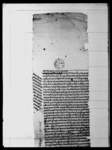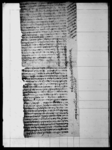A rukkā from King Surendra ordering the execution of Hari Goḍīyā for an act of homicide (VS 1937)
ID: DNA_0014_0004
Edited and
translated by Rajan Khatiwoda
in collaboration with
Simon Cubelic
Created: 2015-09-29;
Last modified: 2018-06-21
For the metadata of the document, click here
The accompanying edition, translation/synopsis and/or commentary are available under the terms of the Creative Commons Attribution-ShareAlike 4.0 International License
Abstract
This rukkā issued by King Surendra to Captain (text: kaptāna) Mvāna Siṃ Svā̃ra Chetrī lays bare formal procedures for carrying out the death penalty on Hari Goḍīyā, who was found guilty of killing Vadala Siṃ Thāpā.Diplomatic edition
[1r-part1]
1श्रीः\[royal seal][1r-part2]
1श्रीमद्दतीप्रचण्ड2भुजदण्डेत्यादि
3श्रीश्रीश्रीमहारा
4जरणउद्दीपसिं
5हराणावहादुर
6केसीयसआइ
7थोङ्लीन्पी
8म्माकोकाङ्वा
9ङ्स्यान्प्राइम्
10मीनिष्टरया
11ण्डकम्याण्डरइ
12नचीफ्¯¯¯¯१1स्वस्तिश्रीमन्महाराजाधीराजकस्यरुक्का¯¯¯
2आगेकप्तान्म्वानसिंस्वाँरछेत्रीप्रतीमआफुगोडीयाजातभै३४साल्काश्रा
3व़णसुदी३रोज१कारातीपाहाडपोषरासीमलटोल्वस्न्यावद
4लसिंथापालाईरातीसुतीनिदायाकावषतपारिवेहक्माषुकु
5रिले२चोट्घोक्रामाहानीकाटिमारिनीजकाकम्वरकोसुनतोला
6१कंपनीरू४०स्मेत्लीमभागीगयाकोसाचोहोभनीमोगलाना
7जील्लैवहराईचईलाकेपल्लापुरमौज्येवझहीवस्न्याहरिगोडीया
8ले३५साल्फागुणवदि७रोज५माअमिनीअदालत्कचहरि
9माकायल्नामालेषीदीयाकामुद्दामाधनमाल्कालालचालेभ
10योवाअरूकेहीईवीलेअर्कालाईहतीयारगैह्रलेहानीरोपीमा
11नीसमार्योभन्यामार्न्यानकाटीन्याजातकोलोग्न्यामानीसभ
12याऐनवमोजिम्कोअंससर्वस्वगरिस्वास्निमानीसभयासर्व
13स्वनगरिदामलगर्नुकाटिन्याजातकोलोग्न्यामानिसभया[...]
14नकोवदलाज्यानकाटिमारिदीनुभंन्याज्यानमाराका९लम्व
15रवेहक्मामानीसकोज्यान्मार्यामानीसमाऐनलेज्यानलि
16नुपर्दाअवउप्रांतफलानुटक्सीरगर्न्याफलानालाईउसलेज्या
17नमार्याकाफलानाठाउमालगीज्यानकाटीमार्नुवाफासि दी
18मार्नुभंन्यालालमोहरमालेषाईसोलालमोहरमाजौनजगा
19मालगीमार्नुभंन्यालेषीयाकोछउसैजगामालगीउसैठाउका
20छोइछीटोहालनुपर्न्याजातकाहातवाटकटाईमराउनुवाफा
21सीदीलाईमार्नुभंन्याज्यानलीदाकोरमुड्दादामल्गर्दाग
22र्न्याको७लम्वरज्यानजान्यामानीसकोज्यानमार्नपठाउदार
23मुड्नुपर्न्यालाइमुडीधपाउदायसलेफलानुटक्सीरगर्योरयस्को
24ज्यानमारिन्याभयोअथवामुडीयाकालाइमुडीयोभंन्या
25सहरकाटोल्टोल्माझाजपीटाइलैजानुभंन्यासोहिमहल्का
26११लम्वरकाऐनवमोजीम्नीजहरिगोडीयालेवदलसींथापा
27लाईधनमाल्कालालचालेरातीसुतीनिदायाकावषतपा[...][...]
28हकमाषुकुरिले२चोट्घोक्रामाहानीकाटिथलैमामार्यामा
29नीजलाईपाहारपोषरभंन्यासवैलेदेषन्येचौरमालगीताहिका
30छोइछीटोहालनुपर्न्याजातकाहातवाटज्यानकोवदलाज्यान
31काटीमारिदिन्याठहराञ्यूंभनीनञामुलुक्जिल्लैकैलालीअमी
32नीकालेफ्टेन्वालनरसींस्वारछेत्रीवीचारिकासिनाथ[...]
33रिले३६साल्श्रावणवदि३०रोज६माअदालत्इटाचप[...]
34मार्फत्चह्रायाकोरपोट्माहुकुम्मर्जीलेस्मेत्सदरभैआया
35वमोजीम्माल्काहाकीम्कपटान्म्वानसिंस्वाँरछेत्रीकाना
36उमालालमोहोरलेषाइ सोलालमोहररमानागरिपठाइ
37दीन्याठहराञ्यूं जोहुकुम्मर्जिभनिअदालत्इटाचपलीवाटसु
38व्वापंडीत्चंद्रकांतअर्ज्याल्ले¯ ¯१¯ ¯कारश्रीमद्राजकुमारकुमारा
39त्मजश्रीकम्यांडरइनचिफ्जनरलधिरसंम्सेरजङ्राणावहादुर
40काहजुरमावींतिपार्दारनीजहरूवाटपनीहाम्राहजुरमावींति
41पारिजाहेरगरायाकामानीजहरिगोडीयाले धनमाल्काला
42लचालेवदलसींथापालाइरातीसुतीनीदायाकोवषतपारिवे
43हकमाषुकुरिले२चोट्घोक्रामाहानीथलैमामार्यावावत्सो
44हीज्यानमाराका९ज्यानलीदाकोरमुड्दादामलगर्दाका[...]
45११लम्वरकाऐनवमोजीम्नीजहरिगोडीयाकोज्यानमार्न
46पथाउदायसलेयोकसुरगर्दायसकोज्यानसजायहुन्याभयो
47भनीझाजपीटाउनलगाइनञामुलुक्कैलालीजील्लाभर
48घुमाइनिजहरिगोडीयालाइचाहारपोषराभंन्याजगाका
49चौरमालगीताहीकाछोइछीटोहालनुपर्न्याजातकाहातवा
50टज्यानकोवदलाज्यानकाटिमारिदीनाकोहुकुम्वक्स्यौइ
51तीसम्वत्१९३७साल्मीतीवैसाषवदि१रोज१शुभम्
[1v]
1मार्फत्राजगुरुद्विजराजपण्डितज्यू1मार्फत्सुव्वाचन्द्रकांतअर्ज्याल्1मार्फत्गुरुप्रोहितषजांचिवामदेवपण्डितज्यू1मार्फत्कम्यांन्डरकर्णैलसनकसिंटंडँलाहुरिछेत्रीTranslation
[1r-part1]
[royal seal]
[1r-part2]
The thrice venerable great king, who is mighty and has an arm like a staff etc., KCSI, Thong Ling Pinma-Ko Kang-Wang-Syang, Prime Minister and Commander-in-Chief Raṇoddīpa Siṃha Rāṇā Bahādura1 ---12
Hail! [This is] a rukkā of the supreme king of great kings.
To Captain Mvāna Siṃ Svā̃ra Chetrī.
Āge: Regarding the trial of Hari Goḍīyā, residing in the maujye of Bajhahī, Pallāpura, Baharāīca, Mogalānā: On Thursday, the 7th of the dark fortnight of Phālguna in the [Vikrama] era year [19]35 (1879 CE), [the accused] confessed his guilt in writing at the Aminī, Adālata and Kacahari [courts], stating: “It is true that on Sunday, the 1st of the bright fortnight of Śrāvaṇa in the [Vikrama] era year [19]34 (1877 CE) I, a member of the Goḍīyā caste, killed Vadala Siṃ Thāpā, residing in Sīmala Ṭola, Pāhāḍapokharā, during the night while he was sleeping by stabbing [him in] the throat twice with a (khukurī) and then fled with 1 tolā of gold and [East India] Company Rs. 40 which he had at his waist.” On Saturday, the 30th of the dark fortnight of Śrāvaṇa in the [Vikrama] era year [19]36 (1879 CE), Lieutenant (text: lephṭen) Bālanarasiṃ3 Svā̃ra Chetrī and Bicārī Kāśinātha [...]ri of the Kailali Aminī, [in] the new territory, submitted the following report through the Iṭācapalī Court [to the king]: “Since Hari Goḍīyā, out of greed for property, killed Vadala Siṃ Thāpā at his place of residence by stabbing [him in] the throat twice during the night while he was sleeping, we have determined to sentence him to death: to take him to the grounds called Pāhāḍapokharā where the public can witness his beheading—of taking life for life—at the hand of a local Untouchable caste member in accordance with the following law: ‘[1] Section 9 of [the article] on homicide: If a person kills another person out of greed for property or for any other reason by striking or stabbing him with a weapon or the like, the offender—if he is a man from a caste whose members cannot be put to death—shall in accordance with the Ain have all his property confiscated and undergo the dāmala4 punishment; whilst if the offender is a woman, she shall undergo the dāmala punishment but without having her property confiscated; whilst if the offender is a man from a caste whose members can be put to death, he shall be executed.’ [2] Section 7 on executing, shaving and dāmala: ‘When the law calls for putting an offender guilty of homicide to death, from now on a lālamohara shall be issued stating that such and such a person who has committed the crime shall be executed by beheading or hanging in such and such place, [the place] where he took [the other’s] life. The offender shall be taken to the place mentioned in the lālamohara and executed by beheading or hanging at the hand of a local Untouchable caste member.’”
[Then] Subbā Paṇḍita Candrakānta Arjyāla (text: Caṃdrakāṃta) on behalf of the Iṭācapalī Court submitted a request to ---1--- (i.e., Prime Minister and Commander-in-Chief Raṇoddīpa Siṃha) and Venerable Prince born of a prince and Commander-in-Chief Dhīra Śamśera Jaṅ Rāṇā Bahādura, stating: “[The above-mentioned] report has been approved by order [of the king], so that we have decided that a lālamohara shall be issued to the chief of the Māla [Aḍḍā], Captain (text: kaptāna) Mvāna Siṃ Svā̃ra Chetrī, and to send it off. Whatever you wish, [please] order.” [Deciding upon the request submitted,] they too have ordered as follows: “Regarding the trial which came to our attention [through the request sent by the [Iṭācapalī Court], we have given the order to sentence Hari Goḍīyā to death as punishment for his having committed the crime: to take [him] with sounding cymbals throughout the new territory of Kailali district and to the grounds called Pāhāḍapokharā and [there] to behead him at the hand of a local Untouchable caste member in accordance with Sections 9 on homicide and 9 (sic) and 11 on executing, shaving and dāmala − Hari Goḍīyā, who out of greed for property killed [Vadala Siṃ Thāpā] unlawfully during the night while he was sleeping by stabbing him twice in the throat with a khukurī.”
On Sunday, the 1st of the dark fortnight of Vaiśākha in the [Vikrama] era year 1937 (1880 CE). [May it be] auspicious.
[1v]
Through (mārphat) RājaguruDvijarāja Paṇḍita
Through Subbā Candrakānta Arjyāla
Through KhajāncīVāmadeva Paṇḍita
Through Commander Colonel Sanaka Siṃ Taṃḍãlāhuri Chetrī
Commentary
It has been always a riddle whether the Muluki Ain of 1854 (hereafter MA), the first systematically formulated legal code of Nepal, enacted by Prime Minister Jaṅga Bahādura Rāṇā, or any of the later emended versions were actually implemented in 19th-century Nepalese legal practice or not. Scholars who have dealt with these texts (cf. Höfer 2004, Michaels 2005) do not provide any concrete evidence that they were. However, the present document, newly reconsidered, answers the question unambiguously: the MA was not simply a theoretical textual work like the dharmaśāstra or nibandha texts but was indeed meant to serve down-to-earth, practical ends. The present document was issued to authorize the death penalty imposed on a murderer who had killed a person during an act of theft. It explains the procedures required for imposing the death penalty in detail. The local court has first to investigate the crime committed and prepare a report suggesting proper punishment after carefully consulting the pertinent paragraphs of the MA. This report is afterwards sent to the king through a higher court called the Iṭācapalī, which adds its own considered observations. It is then approved by the king and is sent on to the prime minister. After approval by him, a lālamohara is issued by the king to the person in the local court authorized to carry out the death penalty. The court procedures discussed above and direct citations of the pertinent articles of the MA prove that it was in fact in effect and used in legal practice.



